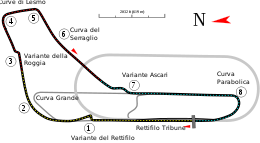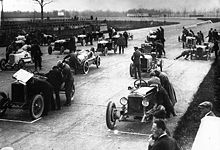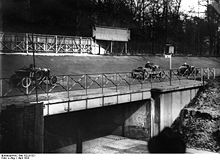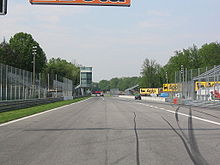- Autodromo Nazionale Monza
-
Autodromo Nazionale Monza 
Location Monza, Italy[1] Time zone GMT +1 Coordinates 45°37′14″N 9°17′22″E / 45.62056°N 9.28944°ECoordinates: 45°37′14″N 9°17′22″E / 45.62056°N 9.28944°E Capacity 113,860 FIA Grade 1 Owner Comune di Monza & Milano[1] Operator SIAS S.p.A.[1] Broke ground 15 May 1922 Opened 3 September 1922 Architect Alfredo Rosselli Major events FIA Formula One
Italian Grand Prix
Italian motorcycle Grand Prix, 1000 km Monza, WTCC, SBK, Race of Two WorldsModern Grand Prix Circuit Surface Asphalt Length 5.793[2][3] km (3.600 mi) Turns 11 Lap record 1:21.046 (  Rubens Barrichello, Ferrari, 2004, F1)
Rubens Barrichello, Ferrari, 2004, F1)Oval Surface Concrete/Asphalt Length 4.250[3] km (2.641 mi) Turns 2 Banking ≈30° Lap record 0:54.0 (  Bob Veith, Bowes Seal Fast, 1958, IndyCar)
Bob Veith, Bowes Seal Fast, 1958, IndyCar)Junior Course Surface Asphalt Length 2.405[3] km (1.494 mi) Combined Course Surface Asphalt Length 10.00 km (6.213 mi) Turns 9 Lap record 2.41.4 (  Phil Hill, Ferrari, 1960, F1)
Phil Hill, Ferrari, 1960, F1)The Autodromo Nazionale Monza is a race track located near the town of Monza, north of Milan, in Italy. The circuit's biggest event is the Formula One Italian Grand Prix, which has been hosted there since the sport's inception.[4]
Built in the Royal Villa of Monza park in a woodland setting,[5] the site has three tracks – the 5.793 kilometres (3.600 mi) Grand Prix track,[2] the 2.405 kilometres (1.494 mi) Junior track,[3] and a decaying 4.250 kilometres (2.641 mi) high speed track with steep bankings.[4] Major features of the main track include the Curva di Lesmo, the Curva Parabolica, and the Variante Ascari. The high speed curve, Curva Grande, is located after a slow corner, but usually taken flat out by Grand Prix cars.
Drivers are on full throttle for most of the lap due to its long straights and fast corners, and is usually the scenario in which the open-wheeled F1 cars show the raw speed they are capable of (372 kilometres per hour (231 mph) during the V10 engined formula). The circuit is generally flat, but has a gradual gradient from the second Lesmos to the Variante Ascari. Due to the low aerodynamic profile needed, with its resulting low downforce,[6] the grip is very low; understeer is a more serious issues than at other circuits, however, the opposite effect, oversteer, is also present in the second sector, requiring the use of a very distinctive opposite lock technique. Since both maximum power, and minimal drag is the key for speed on the straights, only competitors with enough power at their disposal are able to challenge for the top places.[6]
In addition to Formula One, the circuit hosts an endurance event, the 1000 km Monza, which has been run as part of the World Sportscar Championship and the Le Mans Series. Monza also featured the unique Race of Two Worlds events, which attempted to run Formula One and United States Auto Club National Championship cars against each other, and previously held rounds of Grand Prix motorcycle racing, in the Italian motorcycle Grand Prix. Current major events are races of the World Touring Car Championship and the Superbike World Championship, as well as various local championship races.
The Monza circuit has been the arena of many fatal accidents, especially in the early years of the Formula One world championship,[6] and has claimed the lives of 52 drivers and 35 spectators. Track modifications have continuously occurred, to improve spectators safety and reduce curve speeds,[4] but it is still criticised by the current drivers for its lack of run-off areas, most notoriously at the chicane that cuts the Variante della Roggia.[6]
Contents
History
Early history
The first track was built from May to July 1922 by 3,500 workers, financed by the Milan Automobile Club[5] – which created the Società Incremento Automobilismo e Sport (SIAS) (English: Automobile Sport and Encouragement Company) to run the track.[7] The initial form was a 3.4 square kilometres (1.31 sq mi) site with 10 kilometres (6.2 mi) of macadamised road – comprising a 4.5 kilometres (2.80 mi) loop track, and a 5.5 kilometres (3.42 mi) road track.[5][7] The track was officially opened on 3 September 1922, with the maiden race the second Italian Grand Prix held on 10 September 1922.[7]
In 1928, the most serious Italian racing accident to date[5][6] ended in the death of driver Emilio Materassi and 27 spectators at that year's Grand Prix.[5][6] The accident led to further Grand Prix races confinement to the high-speed loop until 1932.[8] The 1933 race was marked by the deaths of three drivers[7] and the Grand Prix layout was changed, with two chicanes added and the longer straights removed.[9]
There was major rebuilding in 1938–39, constructing new stands and entrances, resurfacing the track, moving portions of the track and adding two new bends.[7][8] The resulting layout gave a Grand Prix lap of 6.300 kilometres (3.91 mi), in use until 1954.[10] The outbreak of World War II meant racing at the track was suspended until 1948,[10] and parts of the circuit degraded due to the lack of attention.[4] Monza was renovated over a period of two months at the beginning of 1948,[7] and a Grand Prix was held on 17 October 1948.[10]
High speed oval
In 1954, work began to entirely revamp the circuit, resulting in a 5.750 kilometres (3.573 mi) course, and a new 4.250 kilometres (2.641 mi) high-speed oval with banked sopraelevata curves.[4][11] The two circuits could be combined to re-create the former 10 kilometres (6.214 mi)[4] long circuit, with cars running parallel on the main straight. The track infrastructure was also updated and improved, to better accommodate the teams and spectators.[7][11]
The Automobile Club of Italy held 500-mile (805 km) Race of Two Worlds exhibition competitions, intended to pit United States Auto Club IndyCars against European Formula One and sports cars.[4][11] The races were held on the oval at the end of June in 1957 and 1958,[12] with three 63 lap[13] 267.67 kilometres (166.32 mi) heat races each year, races which colloquially became known as the Monzanapolis series.[12][14] However, concerns were raised among the European drivers that flat-out racing on the banking would be too dangerous,[14] so ultimately only Ecurie Ecosse and Maserati represented European racing at the first running.[15] The American teams had brought special Firestone tyres with them, reinforced to withstand high-speed running on the bumpy Monza surface, but the Maseratis' steering was badly affected by the larger-than-usual tyre size, leading to the Modena-based team withdrawal.[15] Ecurie Ecosse's three Jaguar D-type sports cars used their Le Mans-specification tyres with no ill-effects, but were completely out paced. Two heats in 1957 were won by Jimmy Bryan in his Kuzma-Offenhauser Dean Van Lines Special,[15][16] and the last by Troy Ruttman in the Watson-OffenhauserJohn Zink Special.[17] In 1958, works Jaguar, Ferrari and Maserati teams appeared alongside the Indy roadsters,[11][18] but once again the American cars dominated the event and Jim Rathmann won the three races in a Watson-Offenhauser car.[12]
Formula One used the 10 kilometres (6.214 mi) high speed track in 1955, 1956, 1960 and 1961 Grands Prix.[4][11] Stirling Moss and Phil Hill both won twice in this period, with Hill's win at Monza making him the first American to win a Formula One race.[19] The 1961 race saw the death of Wolfgang von Trips and fifteen spectators, when a collision with Jim Clark's Lotus sent von Trips car airborne and into the barriers on Parabolica.[7][19] Although the accident did not occur on the oval section of the track, the high speeds were deemed unsafe and F1 use of the oval was ended;[20] future Grands Prix were held on the shorter road circuit,[11] with the banking appearing one last time in the film Grand Prix.[20] New safety walls, rails and fences were added before the next race, and the refuelling area was moved further from the track. Chicanes were added before both bankings in 1966, and another fatality in the 1968 1000 km Monza race led to run-off areas added to the curves, with the track layout changing the next year to incorporate permanent chicanes before the banked curves – extending the track length by 100 metres (328 ft).[11] The banking held the last race in 1969 with the 1000 km of Monza, the event moving to the road circuit the next year.[11] The banking still exists, albeit in a decayed state in the years since the last race, escaping demolition in the 1990s.[20]
Circuit changes and modernisation
Both car and Grand Prix motorcycle racing were regular attractions at Monza,[11] but as the speed of the machines were increasing, two chicanes- the Curva Grande at the end of the start/finish straight,[21] and the Ascari, were added in 1972 to reduce racing speeds.[7] This resulted in a new circuit length of 5.755 kilometres (3.576 mi).[21] Grand Prix motorcycles continued to use the un-slowed road track until two serious accidents resulted in five deaths, including Renzo Pasolini and Jarno Saarinen,[21] in 1973, and motorcycle racing did not return to Monza until 1981.[21] These races involved drivers constantly slipstreaming competing cars, which produced several close finishes, such as in 1967, 1969, and 1971; the last year the Italian Grand Prix was run at Monza without chicanes.
The 1972 chicanes were soon seen to be ineffective at slowing cars; the Vialone was remade in 1974,[21] the other, Curve Grande in 1976,[7] and a third also added in 1976 before the Lesmo, with extended run-off areas.[21] The Grand Prix lap after these alterations was increased to 5.800 kilometres (3.604 mi) long.[21]
With technology still increasing vehicle speeds, the track was modified again in 1979, with added kerbs, extended run-off areas, and tyre-barriers improved, to improve safety for drivers off the track.[22] The infrastructure was also improved, with pits able to accommodate 46 cars, and an upgraded paddock and scrutineering facilities.[22] These changes encouraged world championship motorcycling to return in 1981, but further safety work was undertaken through the 1980s.[22] Also in the 1980s the podium, paddock and pits complex, stands,[22][23] and camp site were either rebuilt or improved.[7]
In the safety conscious years following the death of Ayrton Senna in 1994 (albeit at a different track), the three main long curves were "squeezed" in order to install larger gravel traps, shortening the lap to 5.770 kilometres (3.585 mi).[23] In 1997 the stands were reworked to expand capacity to 51,000.[23] In 2000, the chicane on the main straight was altered, changing from a double left-right chicane to a single right-left chicane, in an attempt to reduce the frequent accidents at the starts due to the conformation of the braking area, although it is still deemed unsafe in terms of motorcycle racing. The second chicane was also re-profiled. In the Formula 1 Grand Prix of the same year, the first to use these new chicanes, a marshal, Paolo Gislimberti, was killed by flying debris after a big pileup in the second chicane.[6]
In 2007, the run off area at the second chicane was changed from gravel to asphalt. The length of the track in its current configuration is 5.793 kilometres (3.600 mi).[2] At the 2010 Monza Superbike World Championship round, Italian rider Max Biaggi set the fastest ever motorcycle lap of Monza when he rode his Aprilia RSV4 1000 F to pole position in a time of 1:42.121. In the Superpole qualification for the 2011 race, he improved on this lap time, for a new lap record of 1:41.745 and his speed was captured at 205+ MPH. This contrasts to the fastest ever Formula One lap of Monza in its current configuration, set at the 2004 Italian Grand Prix, when Rubens Barrichello drove his Ferrari F2004 to a time of 1:20.089. This ~20-second discrepancy between race motorcycle and Formula 1 car speeds is attributed to the difference in size of the tyre contact patch and the fact that motorcycles cannot generate high lateral 'G' forces.
A lap of the circuit in a Formula One car
Monza consists of very long straights and tight chicanes, putting a premium on good braking stability and traction. The circuit, of 5.793 kilometres (3.600 mi),[2] is very hard on gearboxes, with many gear changes per lap. Formula 1 engines are at full throttle for nearly 80% of the lap, with engine failures common, notably Fernando Alonso in the 2006 Italian Grand Prix.
Formula One cars are set up with minimal wing angle, to ensure the lowest level of drag on the straights. There are only 3 proper corners at Monza, the two Lesmos and the Parabolica, so cars are set up with maximum performance on the straights.
Cars approach the first corner at 340 kilometres per hour (210 mph) in seventh gear,[2] and brake at about 120 metres (390 ft) before the first chicane – the Variante del Rettifilo, entering at 86 kilometres per hour (53 mph) in first gear, and exiting at 74 kilometres per hour (46 mph) in second gear.[2] This is the scene of many first lap accidents. Higher kerbs at the first two chicanes were installed in 2009 to prevent cutting.[24]
It is important to accelerate out of the first chicane as straight as possible and with minimal wheelspin, as a lot of time will be lost through the Curva Grande down to the Variante della Roggia chicane in 7th gear, at 330 kilometres per hour (210 mph).[2] The braking point is just under the bridge. The kerbs are very vicious, and it is very easy for a car to spin as Kimi Räikkönen did in 2005. This chicane is probably the best overtaking chance on the lap, as it is the only one with the "slow corner, long straight, slow corner", one of the characteristics of the modern circuits.
The Curva di Lesmo are two corners that are not as fast as they used to be, but are still challenging corners. The first is blind, entered at 264 kilometres per hour (164 mph) 5th gear, and dropping to 4th gear at 193 kilometres per hour (120 mph),[2] and has a slight banking. The second is 5th gear entry at 260 kilometres per hour (160 mph), apexing in 3rd gear at 178 kilometres per hour (111 mph),[2] and very important and all the kerb is used. A mistake at one of these corners will either result in a spin into the gravel, or an overtaking move into the Variante Ascari chicane.
The downhill straight down to the Variante Ascari chicane is very bumpy under the bridge. The Variante Ascari chicane is a very tricky sequence of corners, and is key to the lap time.
The final challenge is the Curva Parabolica, approaching at 335 kilometres per hour (208 mph) in 7th gear,[2] cars quickly dance around the corner, apexing in fourth gear at 215 kilometres per hour (134 mph),[2] and exiting in 5th gear at 285 kilometres per hour (177 mph)[2] accelerating onto the main start/finish straight. A good exit and slipstream off a fellow driver along the main straight could produce an overtaking opportunity under heavy braking into the Variante del Rettifilio chicane, however it is difficult to follow a leading car closely through the Parabolica as the tow will reduce downforce and cornering speed.
Maximum speed achieved in a 2009 Formula One car is 340 kilometres per hour (210 mph), achieved at the end of the start/finish straight.[2] They achieve a maximum g-force of 3.80 through turn 7, the second Lesmo.[2]
Rubens Barrichello recorded the fastest ever pole position lap at Monza in 2004 when he lapped in 1m20.089s, 161.802 mph. But in the pre-qualifying session for the same race (which did not count for a grid position but only Q-running order), Juan Pablo Montoya lapped the track in 1m19.525s (162.949 mph) which remains the fastest lap ever recorded in an F1 car.[25]
Deaths from crashes
Main article: List of Autodromo Nazionale Monza fatal accidents- 1922 Fritz Kuhn (Austro-Daimler), killed during practice for the 1922 Italian Grand Prix[9]
- 1923 Enrico Giaccone, riding as passenger in a Fiat 805 during private testing, with Pietro Bordino driving[9]
- 1923 Ugo Sivocci (Alfa Romeo P1), killed during practice for the 1923 Italian Grand Prix[9]
- 1924 Count Louis Zborowski (Mercedes), killed after crashing into a tree at Lesmo during the 1924 Italian Grand Prix[9]
- 1928 Emilio Materassi and 27 spectators killed after Materassi crashed his Talbot into the grandstand during the 1928 Italian Grand Prix[5][6][9]
- 1931 Luigi Arcangeli (Alfa Romeo), killed after crashing at Lesmo during practice for the 1931 Italian Grand Prix[9]
- 1933 Giuseppe Campari (Alfa Romeo Tipo B 2.6 litre), Mario Umberto Borzacchini (Maserati 8C-3000) and Count Stanislas Czaykowski (Bugatti), killed after crashing at the south banking during the 1933 Monza Grand Prix[8][9]
- 1954 Rupert Hollaus, killed during practice during the Italian motorcycle Grand Prix
- 1955 Alberto Ascari, killed during private testing at what is now the Ascari chicane, driving a Ferrari 750 Monza, just four days after his crash in the 1955 Monaco Grand Prix[6]
- 1961 Count Wolfgang von Trips[6][11] and 14 spectators killed after von Trips collided with Jim Clark approaching the Parabolica on the second lap of the 1961 Italian Grand Prix
- 1965 Bruno Deserti, killed during Ferrari official test prior to Le Mans in a Ferrari P2/3 4000 cc
- 1965 Tommy Spychiger, killed during 1000K Sports car race in Ferrari 365P2[11]
- 1970 Jochen Rindt, killed when crashing at the Parabolica during qualifying for the 1970 Italian Grand Prix[6]
- 1973 Renzo Pasolini, Jarno Saarinen killed in a mass crash at the Curva Grande during the 250 cc class of the Nations Grand Prix (Prior to 1990, the Italian round was called the Nations Grand Prix)[21]
- 1973 Carlo Chionio, Renzo Colombini and Renato Galtrucco during a race for 500 cc Juniores Italian motorcycle championship[21]
- 1974 Silvio Moser, died in hospital one month after suffering injuries at the 1000 km Monza race
- 1978 Ronnie Peterson, died in hospital after crashing during the start of the 1978 Italian Grand Prix[6][7][21]
- 1998 Michael Paquay, Belgian motorbike racer, died after a crash in practice for the Italian round of World Supersport Championships, Honda CBR 600
- 2000 Paolo Gislimberti, a marshal hit by debris from a first-lap accident at the Roggia chicane during the Italian Grand Prix[6][26]
References
- ^ a b c "Autodromo Nazionale Monza – Company profile". Autodromo Nazionale Monza. MonzaNet.it. ©2007. http://www.monzanet.it/eng/company_profile.aspx. Retrieved 17 September 2009.
- ^ a b c d e f g h i j k l m n "Formula 1 Gran Premio Santander D'Italia 2009 (Monza) – interactive circuit map". Formula One Administration Ltd. Formula1.com. © 1999-2009. http://www.formula1.com/races/in_detail/italy_818/. Retrieved 17 September 2009.
- ^ a b c d "Autodromo Nazionale Monza – Areas & Structures". Autodromo Nazionale Monza. MonzaNet.it. ©2007. Archived from the original on June 18, 2008. http://web.archive.org/web/20080618011356/http://www.monzanet.it/eng/spazi_strutture.aspx. Retrieved 17 September 2009.
- ^ a b c d e f g h "The hidden history of the Monza banking". Formula One Administration Ltd. Formula1.com. 30 August 2005. http://www.formula1.com/news/features/2005/8/3500.html. Retrieved 17 September 2009.
- ^ a b c d e f "1922–1928: Construction and first races on the original tracks". Autodromo Nazionale Monza. MonzaNet.it. ©2007. Archived from the original on June 11, 2008. http://web.archive.org/web/20080611175248/http://www.monzanet.it/eng/storia_1922_28.aspx. Retrieved 17 September 2009.
- ^ a b c d e f g h i j k l m "Fórmula 1: los pilotos tienen miedo por la seguridad en Monza [Formula 1: the drivers are afraid for safety at Monza]" (in Spanish). Clairín.com. 05/09/2006. http://www.clarin.com/diario/2006/09/05/um/m-01265869.htm. Retrieved 17 September 2009.
- ^ a b c d e f g h i j k l "Autodromo Nazionale di Monza – History". The Formula One DataBase. F1db.com. 6 April 2005. http://www.f1db.com/f1/page/Autodromo_Nazionale_di_Monza. Retrieved 17 September 2009.
- ^ a b c "1929–1939: In consequence of the Materassi's accident, races are run on the alternative tracks". Autodromo Nazionale Monza. MonzaNet.it. ©2007. Archived from the original on April 15, 2008. http://web.archive.org/web/20080415212757/http://www.monzanet.it/eng/storia_1929_39.aspx. Retrieved 17 September 2009.
- ^ a b c d e f g h "8W – When? – 1933 Monza GP, "Black Sunday"". Forix.autosport.com. May 2001. http://forix.autosport.com/8w/monza33.html. Retrieved 17 September 2009.
- ^ a b c "1940–1954: After the war interruption, the activity starts again in 1948". Autodromo Nazionale Monza. MonzaNet.it. ©2007. Archived from the original on April 15, 2008. http://web.archive.org/web/20080415212801/http://www.monzanet.it/eng/storia_1940_54.aspx. Retrieved 17 September 2009.
- ^ a b c d e f g h i j k "1955–1971: Construction of the high speed track and other important works". Autodromo Nazionale Monza. MonzaNet.it. ©2007. Archived from the original on April 15, 2008. http://web.archive.org/web/20080415212806/http://www.monzanet.it/eng/storia_1955_71.aspx. Retrieved 17 September 2009.
- ^ a b c "Autodromo Nazionale di Monza". ChampCarStats.com. © 2009. http://www.champcarstats.com/tracks/monza.htm. Retrieved 17 September 2009.
- ^ "1958 500 Miglia di Monza Heat 1". ChampCarStats.com. © 2009. http://www.champcarstats.com/races/1958nc1.htm. Retrieved 17 September 2009.
- ^ a b "History of Monza GP". About Milan. http://www.aboutmilan.com/history-of-monza-track.html. Retrieved 2010-10-08.
- ^ a b c "1957 500 Miglia di Monza Heat 1". ChampCarStats.com. © 2009. http://www.champcarstats.com/races/1957nc1.htm. Retrieved 17 September 2009.
- ^ "500 Miglia di Monza Heat 2". ChampCarStats.com. http://www.champcarstats.com/races/1957nc2.htm. Retrieved 23 November 2010.
- ^ "500 Miglia di Monza Heat 3". ChampCarStats.com. http://www.champcarstats.com/races/1958nc3.htm. Retrieved 23 November 2010.
- ^ "1958 500 Miglia di Monza Heat 2". ChampCarStats.com. © 2009. http://www.champcarstats.com/races/1958nc2.htm. Retrieved 17 September 2009.
- ^ a b "A history of the Italian Grand Prix". Formula1.com. Formula One Administration Ltd.. 2004-09-08. http://www.formula1.com/news/features/2004/9/2159.html. Retrieved 23 November 2010.
- ^ a b c "The hidden history of the Monza banking". Formula1.com. Formula One Administration Ltd.. 2005-08-30. http://www.formula1.com/news/features/2005/8/3500.html. Retrieved 23 November 2010.
- ^ a b c d e f g h i j "1972–1978: Chicane and variants to reduce the high speed". Autodromo Nazionale Monza. MonzaNet.it. ©2007. Archived from the original on June 11, 2008. http://web.archive.org/web/20080611175253/http://www.monzanet.it/eng/storia_1972_78.aspx. Retrieved 17 September 2009.
- ^ a b c d "1979–1988: New works to update the circuit". Autodromo Nazionale Monza. MonzaNet.it. ©2007. Archived from the original on April 15, 2008. http://web.archive.org/web/20080415212811/http://www.monzanet.it/eng/storia_1979_88.aspx. Retrieved 17 September 2009.
- ^ a b c "1989–1997: New pit complex and the interventions for the security". Autodromo Nazionale Monza. MonzaNet.it. ©2007. Archived from the original on April 13, 2008. http://web.archive.org/web/20080413073732/http://www.monzanet.it/eng/storia_1989_97.aspx. Retrieved 17 September 2009.
- ^ "Bigger kerbs installed for Monza chicanes". formula 1.com. 08/09/2009. http://www.formula1.com/news/headlines/2009/9/9881.html. Retrieved 21 September 2009.
- ^ "Monza facts and stats – Feature – F1 | ITV Sport". Itv-f1.com. 2006-09-04. http://www.itv-f1.com/Feature.aspx?Type=General&id=37200&PO=37200. Retrieved 2010-12-11.
- ^ Grand Prix death casts doubt over Monza circuit, CNN.com story, Sept. 11, 2000, accessed Nov. 17, 2008[dead link]
External links
- Autodromo Nazionale Monza official website
- SpazioEventi.info Monza Corporate official site
Categories:- Motorsport venues in Italy
- Buildings and structures in Monza
- Formula One circuits
- Italian Grand Prix
- Grand Prix motorcycle racing circuits
- World Superbike racing circuits
Wikimedia Foundation. 2010.







